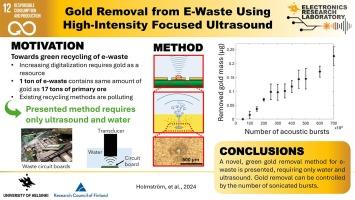利用高强度聚焦超声波去除电子垃圾中的金。
IF 8.7
1区 化学
Q1 ACOUSTICS
引用次数: 0
摘要
由于技术发展和数字化所需的电子产品数量不断增加,对稀有贵金属(RPM)(如黄金)的需求也在不断增加。由于稀有,原始 RPM 开采变得越来越困难和昂贵。与此同时,全球每年产生的电子垃圾超过 6200 万吨。电子垃圾中黄金和其他 RPM 的高浓度使其成为回收利用的绝佳来源。遗憾的是,目前的回收方法需要分离不同的金属,而且目前的火法冶金和湿法冶金工艺还会产生有毒污染物和大量废水,并需要高腐蚀性物质。在此,我们提出了一种以回收为目的的全新除金方法,该方法仅使用水和高强度聚焦超声波,通过空化作用诱导材料侵蚀。首先使用 11.8MHz 超声波传感器对样品进行成像,以确定废弃印刷电路板(PCB)上金涂层焊盘的位置,然后仅去除金层。我们证明,金的去除可以通过发射超声波脉冲的次数来控制,而且当只有微量的镍层也被去除时,能量效率是最佳的。只去除金层还能减少进一步处理步骤的需要。因此,这种更环保的电子废物除金方法与联合国可持续发展目标 12 "确保可持续消费和生产模式 "不谋而合,并为之做出了贡献。本文章由计算机程序翻译,如有差异,请以英文原文为准。

Gold removal from e-waste using high-intensity focused ultrasound
The demand for rare and precious metals (RPMs), e.g. gold, is increasing, as these are used in the ever-increasing amount of electronics needed for technological development and digitalization. Due to their rarity, virgin mining of RPMs is becoming more difficult and expensive. At the same time, over 62 Mt of e-waste is created globally each year. The high concentration of gold and other RPMs in e-waste makes it an excellent source for recycling. Unfortunately, current recycling methods need to separate the different metals and the current pyrometallurgical and hydrometallurgical processes also create toxic pollutants, large amounts of wastewater and require highly corrosive substances. Here we present a new method for gold removal for the purpose of recycling, using only water and high-intensity focused ultrasound to induce material erosion through cavitation. An 11.8 MHz ultrasonic transducer is used to first image the sample to locate gold-coated pads on discarded printed circuit boards (PCBs) and subsequently to remove only the gold layer. We demonstrate that the gold removal can be controlled by the number of transmitted ultrasonic bursts and that the energy efficiency is optimal when only minute amounts of the nickel layer beneath are also removed. Removing solely the gold layer also decreases the need for further processing steps. This greener gold removal method for e-waste is therefore well aligned with, and contributing to, the United Nations Sustainable Development Goal 12: Ensure sustainable consumption and production patterns.
求助全文
通过发布文献求助,成功后即可免费获取论文全文。
去求助
来源期刊

Ultrasonics Sonochemistry
化学-化学综合
CiteScore
15.80
自引率
11.90%
发文量
361
审稿时长
59 days
期刊介绍:
Ultrasonics Sonochemistry stands as a premier international journal dedicated to the publication of high-quality research articles primarily focusing on chemical reactions and reactors induced by ultrasonic waves, known as sonochemistry. Beyond chemical reactions, the journal also welcomes contributions related to cavitation-induced events and processing, including sonoluminescence, and the transformation of materials on chemical, physical, and biological levels.
Since its inception in 1994, Ultrasonics Sonochemistry has consistently maintained a top ranking in the "Acoustics" category, reflecting its esteemed reputation in the field. The journal publishes exceptional papers covering various areas of ultrasonics and sonochemistry. Its contributions are highly regarded by both academia and industry stakeholders, demonstrating its relevance and impact in advancing research and innovation.
 求助内容:
求助内容: 应助结果提醒方式:
应助结果提醒方式:


